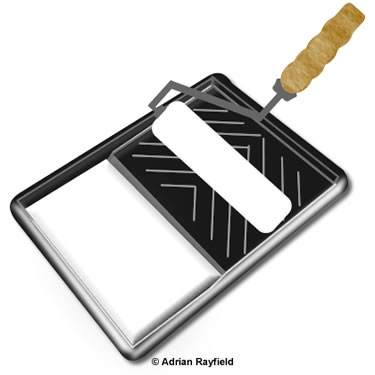Painting, decorating and home improvement tips blog
12 essential tools for your DIY decorating toolbox
Posted by Adrian
April 4th, 2011

Tools you should have in your toolbox
The following is a basic list of tools you should consider having in your decorating toolbox, you may need more than those listed but these are really the twelve essentials to get you started. This list doesn’t include sundries such as sandpaper.
Dustsheet, heavy and light
Dustsheets are needed to cover over furniture and flooring, they can be heavy weight or lightweight or even plastic disposable ones depending on the job they are required for.
Scrapers
You may find having more than one scraper of use, a thin bladed one for things like opening cracks and a wider one for filling cracks, scraping walls and ceilings and removing wallpaper.
Screwdriver
A selection of screwdrivers would be useful for removing things such as shelves, door furniture and electrical items* such as wall lights, ceiling lights, switches and sockets.
Sharp knife
This can be used to open tubes of decorators caulk, packets of filler and wallpaper paste and for cutting wallpaper, or even to sharpen your pencil !!
Hammer
Not to do decorating a such, but a useful tool for pulling our rawl plugs, nails from walls and can be used to knock off any loose plaster or render. But don’t be too heavy handed otherwise your will end up making more work than needs doing.
Paintbrushes
A selection of good quality paintbrushes is always needed in your toolbox, a range from ½ inch up to 3 or 4 inch is ideal, the most commonly used are 1 ½ and 1 inch brushes.
Caulk gun
An essential bit of kit for apply decorators caulk.
Roller cage/frame
A well-built roller cage should last you a long time, or even years depending on how much you use it. A 9 inch roller will be most useful allowing you to cover walls and ceilings quickly, a mini roller, often referred to as ‘rad rollers’, these come in short or long arm, the long arm frame is ideal for painting walls behind radiators whereas the short arm along with the mini roller sleeve can be used for small area’s. The mini roller is also used for gloss roller sleeves for painting large flat area’s such as flush doors.
Roller sleeve
To go with your roller cage, when you buy them make sure they will fit your cage as the diameter of the hole differs from 1 ½ inch to 1 ¾ inch. For the mini rollers, a gloss foam roller as well as a emulsion sleeves will come in handy.

Paint tray
You will need a tray for your 9 inch roller and you could also get a smaller tray for you mini roller but it’s not essential as you can use the 9 inch roller tray. If you can find a deep tray it will make life easier as you don’t have to keep topping the tray up with paint.
Paint kettle
These can be either plastic or metal but are useful to decant the paint into for cutting in without having to carry a full tin of paint and running the risk of spilling it if it’s a full tin. Also, when using paint for a long time the paint can skin over so only decanting what you need and topping up is the best option.
Masking tape
This can be used to hold dustsheets in place, masking skirting and architraves and a handy thing to have in your toolbox.
*Always turn of the mains before removing anything electrical, if your unsure hire a professional electrician.
Tags: Decorating, Decorator Caulk, Dustsheet, Hammer, Knife, Masking Tape, Paint kettle, Paint tray, Paintbrushes, Roller Cage, Roller Sleeve, Scraper, Screwdriver, Toolbox, Tools, Wallpaper
Posted in Decorating Tips | No Comments »
